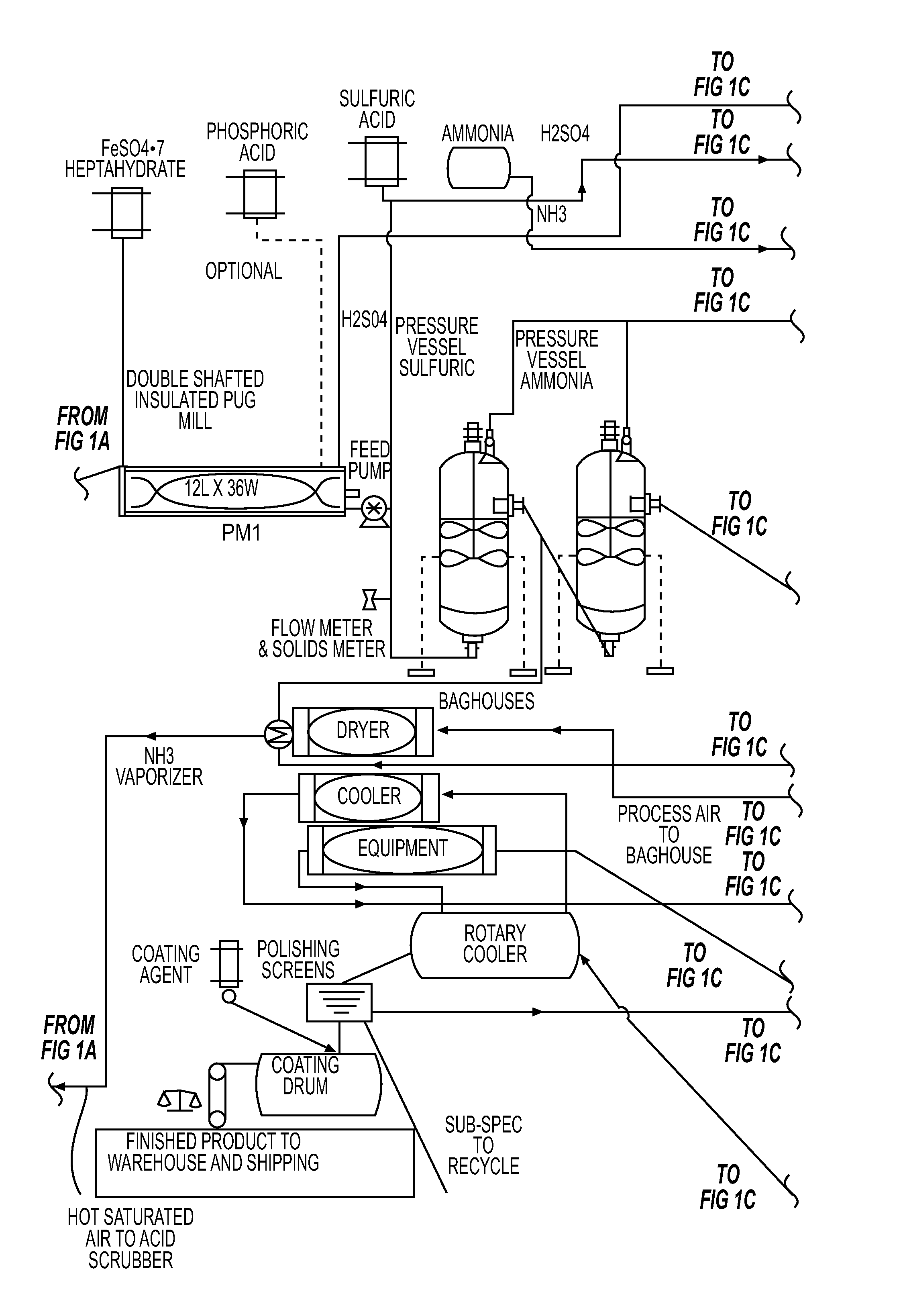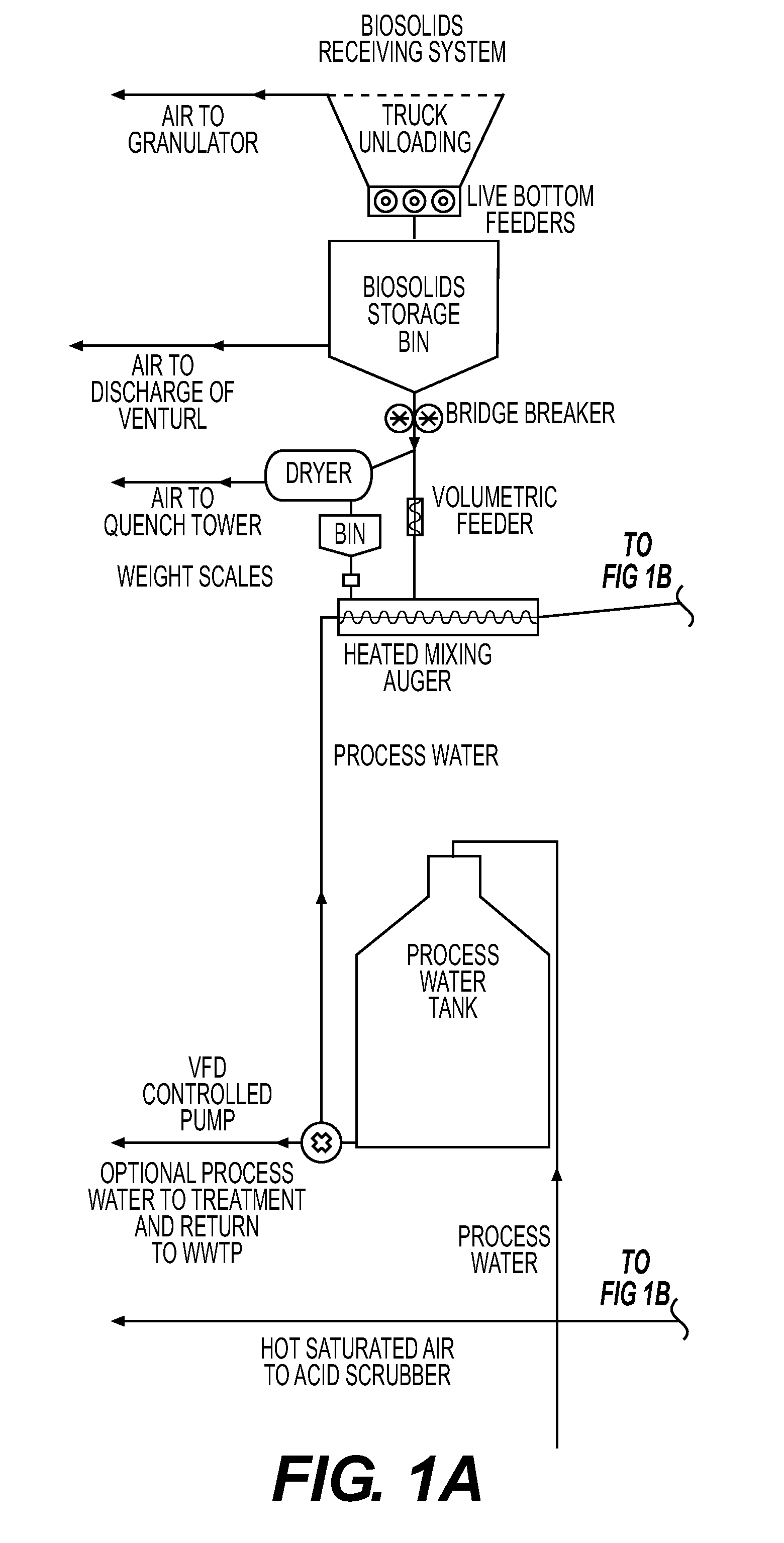High value organic-enhanced inorganic fertilizers
a technology of organic fertilizers and inorganic fertilizers, applied in the field of high value organic fertilizers, can solve the problems of contaminated smoke spoilage, high cost in environmental damage, and high cost of procedures, and achieve the effect of increasing the value of fertilizers
- Summary
- Abstract
- Description
- Claims
- Application Information
AI Technical Summary
Benefits of technology
Problems solved by technology
Method used
Image
Examples
example 1
[0096]To 900 grams of raw biosolids with a solids content of 16 percent were added 15 grams of process water, 38.6 grams of iron sulfate, and 21.8 grams phosphoric acid. The mixture was thoroughly mixed (10 rpm) to a viscosity of about 1,250 cP, and then heated in an agitated pressure vessel to about 54 C (130 F) and vented to maintain atmospheric pressure of 0 psig (ambient). 411.4 grams of 93 percent sulfuric acid were added to the heated mixture and allowed to attain maximum temperature for 5 minutes. The temperature of the mixture rose to about 104 C (220 F) and the vessel was vented to maintain atmospheric pressure at 0 psig. The viscosity ranged from 760 cP to 3630 cP dependent on induced shear rates.
example 2
[0097]To 730 grams of raw biosolids with a solids content of 23.5 percent were added 56 grams of process water, 45.9 grams of iron sulfate, and 25.9 grams phosphoric acid. The mixture was heated in an agitated pressure vessel to 54 C (130 F) and vented to maintain atmospheric pressure of 0 psig. 490.1 grams of 93 percent sulfuric acid were added to the heated mixture and allowed to attain temperature and maximum pressure for 5 minutes. The temperature of the mixture rose to about 116 C (241 F) and the pressure to a maximum of 40 psig. At the maximum pressure, 165 grams of ammonia were added and the ammoniated mixture allowed to attain temperature and maximum pressure for 5 minutes after which the temperature rose to 183 C (362 F) and the pressure rose to 111 psig. The viscosity was about 518 to 968 cP dependent on induced shear rates.
example 3
[0098]To 720 grams of biosolids with a pH of 6.7 and a solids content of 24.5 percent were added 50 grams of process water, and 47.2 grams of iron sulfate. The mixture was thoroughly mixed and then heated in an agitated pressure vessel until reaching about 54 C (130 F), and a maximum pressure of 26 psig. 503.9 grams of 93 percent sulfuric acid were added to the heated and pressurized mixture. The temperature of the mixture rose to 114 C (238 F) and the pressure to a maximum of 58 psig. After 5 minutes and at the maximum pressure, 170 grams of ammonia were added and the ammoniated mixture was allowed to attain temperature and maximum pressure for 5 minutes after which time the temperature of the mixture rose to 182 C (360 F) and the pressure to 109 psig. The liquefied mixture was then sprayed into a granulator and the entire mixture was dried. The resulting mixture in the granulator contained about 80 percent by weight of recycled fertilizer granules. Granules were sized to about 2 t...
PUM
| Property | Measurement | Unit |
|---|---|---|
| pressure | aaaaa | aaaaa |
| pressure | aaaaa | aaaaa |
| viscosity | aaaaa | aaaaa |
Abstract
Description
Claims
Application Information
 Login to View More
Login to View More - R&D
- Intellectual Property
- Life Sciences
- Materials
- Tech Scout
- Unparalleled Data Quality
- Higher Quality Content
- 60% Fewer Hallucinations
Browse by: Latest US Patents, China's latest patents, Technical Efficacy Thesaurus, Application Domain, Technology Topic, Popular Technical Reports.
© 2025 PatSnap. All rights reserved.Legal|Privacy policy|Modern Slavery Act Transparency Statement|Sitemap|About US| Contact US: help@patsnap.com



